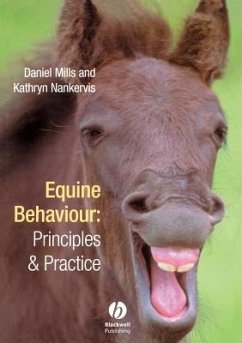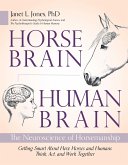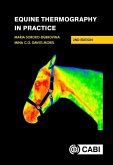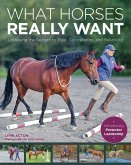Daniel S. Mills (De Montfort University), Kathryn J. Nankervis (Hartpury College)
Equine Behaviour
Principles and Practice
Daniel S. Mills (De Montfort University), Kathryn J. Nankervis (Hartpury College)
Equine Behaviour
Principles and Practice
- Broschiertes Buch
- Merkliste
- Auf die Merkliste
- Bewerten Bewerten
- Teilen
- Produkt teilen
- Produkterinnerung
- Produkterinnerung
Enables students, trainers, riders and horse owners to understand the fundamental principles behind the behavior of horses and how to apply them in different situations in practice. This book looks at the constraints which apply to the modern horse because of its evolutionary history and the nature of the evolutionary process itself.
Andere Kunden interessierten sich auch für
![Equine Exercise Physiology Equine Exercise Physiology]() David MarlinEquine Exercise Physiology120,99 €
David MarlinEquine Exercise Physiology120,99 €![Solving Equine Behaviour Problems Solving Equine Behaviour Problems]() Rose M Scofield (UK Oxford Brookes University)Solving Equine Behaviour Problems43,99 €
Rose M Scofield (UK Oxford Brookes University)Solving Equine Behaviour Problems43,99 €![Equine Injury, Therapy and Rehabilitation Equine Injury, Therapy and Rehabilitation]() Mary BromileyEquine Injury, Therapy and Rehabilitation61,99 €
Mary BromileyEquine Injury, Therapy and Rehabilitation61,99 €![Horse Brain, Human Brain Horse Brain, Human Brain]() Janet JonesHorse Brain, Human Brain33,99 €
Janet JonesHorse Brain, Human Brain33,99 €![Equine Thermography in Practice Equine Thermography in Practice]() Maria Soroko-DubrovinaEquine Thermography in Practice64,99 €
Maria Soroko-DubrovinaEquine Thermography in Practice64,99 €![Fraser's the Behaviour and Welfare of the Horse Fraser's the Behaviour and Welfare of the Horse]() Fraser's the Behaviour and Welfare of the Horse65,99 €
Fraser's the Behaviour and Welfare of the Horse65,99 €![What Horses Really Want What Horses Really Want]() Lynn ActonWhat Horses Really Want34,99 €
Lynn ActonWhat Horses Really Want34,99 €-
-
-
Enables students, trainers, riders and horse owners to understand the fundamental principles behind the behavior of horses and how to apply them in different situations in practice. This book looks at the constraints which apply to the modern horse because of its evolutionary history and the nature of the evolutionary process itself.
Hinweis: Dieser Artikel kann nur an eine deutsche Lieferadresse ausgeliefert werden.
Hinweis: Dieser Artikel kann nur an eine deutsche Lieferadresse ausgeliefert werden.
Produktdetails
- Produktdetails
- Verlag: Blackwell Publishers
- 1998.
- Seitenzahl: 240
- Erscheinungstermin: 16. September 1998
- Englisch
- Abmessung: 243mm x 172mm x 18mm
- Gewicht: 428g
- ISBN-13: 9780632048786
- ISBN-10: 0632048786
- Artikelnr.: 14171135
- Herstellerkennzeichnung
- Libri GmbH
- Europaallee 1
- 36244 Bad Hersfeld
- gpsr@libri.de
- Verlag: Blackwell Publishers
- 1998.
- Seitenzahl: 240
- Erscheinungstermin: 16. September 1998
- Englisch
- Abmessung: 243mm x 172mm x 18mm
- Gewicht: 428g
- ISBN-13: 9780632048786
- ISBN-10: 0632048786
- Artikelnr.: 14171135
- Herstellerkennzeichnung
- Libri GmbH
- Europaallee 1
- 36244 Bad Hersfeld
- gpsr@libri.de
Daniel Mills BVSc, MRCVS is a Veterinary Surgeon and Senior Lecturer in Behavioural Studies at De Montfort University, Lincoln, from where he also runs a referral behaviour clinic, and Kathryn Nankervis BSC (Hons), MSc is a Lecturer in Equine Physiology at De Montfort University, Lincoln. She is also the founder of the Equi-Tutor Learning Programme.
Preface vii
Acknowledgements viii
Part One: Understanding Behaviour Concepts 1
1 Approaches to the Study of Behaviour 3
What is behavior 3
Ethology versus psychology 6
A brief guide to conducting a behaviour study 9
Conclusion 15
Topics for discussion 16
References and further reading 16
2 Origins of Behaviour 18
An evolutionary approach to understanding behavior 18
Lamarck versus Darwin 19
Genes not individuals 22
Evolutionary throwbacks and genetic jumps 26
Adaptation and apparent stupidity in domestic horses 27
Evolution and the variety of behavior 29
Conclusion 31
Topics for discussion 31
References and further reading 32
3 The Evolutionary History of the Horse 33
Introduction 33
Early evolution of the horse 38
The arrival of Equus 43
The origins of the modern breeds 45
Domestication and its consequences 47
Topics for discussion 52
References and further reading 52
4 The Lifetime Development of Behaviour 53
Instinctive and learned behaviour, what is the difference? 53
Sensitive phases for specia1 times specific associations 56
Using play for better management 58
Using natural biases in development to improve management 60
Conclusion 65
Topics for discussion 65
References and further reading 66
Part Two: Mechanisms of Behaviour 67
5 The Processing, of Information 69
Introduction 69
The nervous system 69
Neural transmission 72
Central processing 80
Behavioural motivation 84
Autonomic and somatic nervous system 88
Topics·for discussion 89
References and further reading 90
6 The Special Senses 91
Sight 91
Hearing 99
Chemoreception 102
Cutaneous sensation 107
Topics for discussion 108
References and further reading 108
7 Communication and Social Organisation 110
Communication 110
Social organisation 125
The composition of the group 129
The social structure of the group 129
The dynamics of the group 133
How horses defend their resources 134
Conclusion 136
Topics for discussion 137
References and further reading 137
8 Sexual and Reproductive Behaviour of Horses 139
Basic genetic foundation of the individual's sexuality 139
Normal mare specific behavior 140
Normal sexual specific behaviour l49
Modifiers of the genetic blueprint 153
Conclusion 160
Topics for discussion 160
References and further reading l60
Part Three: The flexibility of Behaviour and its Management 163
9 Learning and Training 165
Psychological processes 165
A few basic procedures 167
App1ying reinforcement to train new behaviours 176
Punishment and its problems 180
General guidelines to training new behaviours 182
Learning beyond a change in behaviour 183
Training techniques for problem behaviours 186
Conclusion 193
Topics for discussion 164
References and further reading 194
10 Welfare 196
Understanding welfare 196
What is right is not always the same as what is good 196
Measuring welfare 197
ls the domestic horse a fish out of water? 205
Stereotypies 210
Principles of treatment for stereotypies and other behaviour problems 220
Conclusion 224
Topics for discussion 224
References and further reading 225
Appendix 226
Index 227
Acknowledgements viii
Part One: Understanding Behaviour Concepts 1
1 Approaches to the Study of Behaviour 3
What is behavior 3
Ethology versus psychology 6
A brief guide to conducting a behaviour study 9
Conclusion 15
Topics for discussion 16
References and further reading 16
2 Origins of Behaviour 18
An evolutionary approach to understanding behavior 18
Lamarck versus Darwin 19
Genes not individuals 22
Evolutionary throwbacks and genetic jumps 26
Adaptation and apparent stupidity in domestic horses 27
Evolution and the variety of behavior 29
Conclusion 31
Topics for discussion 31
References and further reading 32
3 The Evolutionary History of the Horse 33
Introduction 33
Early evolution of the horse 38
The arrival of Equus 43
The origins of the modern breeds 45
Domestication and its consequences 47
Topics for discussion 52
References and further reading 52
4 The Lifetime Development of Behaviour 53
Instinctive and learned behaviour, what is the difference? 53
Sensitive phases for specia1 times specific associations 56
Using play for better management 58
Using natural biases in development to improve management 60
Conclusion 65
Topics for discussion 65
References and further reading 66
Part Two: Mechanisms of Behaviour 67
5 The Processing, of Information 69
Introduction 69
The nervous system 69
Neural transmission 72
Central processing 80
Behavioural motivation 84
Autonomic and somatic nervous system 88
Topics·for discussion 89
References and further reading 90
6 The Special Senses 91
Sight 91
Hearing 99
Chemoreception 102
Cutaneous sensation 107
Topics for discussion 108
References and further reading 108
7 Communication and Social Organisation 110
Communication 110
Social organisation 125
The composition of the group 129
The social structure of the group 129
The dynamics of the group 133
How horses defend their resources 134
Conclusion 136
Topics for discussion 137
References and further reading 137
8 Sexual and Reproductive Behaviour of Horses 139
Basic genetic foundation of the individual's sexuality 139
Normal mare specific behavior 140
Normal sexual specific behaviour l49
Modifiers of the genetic blueprint 153
Conclusion 160
Topics for discussion 160
References and further reading l60
Part Three: The flexibility of Behaviour and its Management 163
9 Learning and Training 165
Psychological processes 165
A few basic procedures 167
App1ying reinforcement to train new behaviours 176
Punishment and its problems 180
General guidelines to training new behaviours 182
Learning beyond a change in behaviour 183
Training techniques for problem behaviours 186
Conclusion 193
Topics for discussion 164
References and further reading 194
10 Welfare 196
Understanding welfare 196
What is right is not always the same as what is good 196
Measuring welfare 197
ls the domestic horse a fish out of water? 205
Stereotypies 210
Principles of treatment for stereotypies and other behaviour problems 220
Conclusion 224
Topics for discussion 224
References and further reading 225
Appendix 226
Index 227
Preface vii
Acknowledgements viii
Part One: Understanding Behaviour Concepts 1
1 Approaches to the Study of Behaviour 3
What is behavior 3
Ethology versus psychology 6
A brief guide to conducting a behaviour study 9
Conclusion 15
Topics for discussion 16
References and further reading 16
2 Origins of Behaviour 18
An evolutionary approach to understanding behavior 18
Lamarck versus Darwin 19
Genes not individuals 22
Evolutionary throwbacks and genetic jumps 26
Adaptation and apparent stupidity in domestic horses 27
Evolution and the variety of behavior 29
Conclusion 31
Topics for discussion 31
References and further reading 32
3 The Evolutionary History of the Horse 33
Introduction 33
Early evolution of the horse 38
The arrival of Equus 43
The origins of the modern breeds 45
Domestication and its consequences 47
Topics for discussion 52
References and further reading 52
4 The Lifetime Development of Behaviour 53
Instinctive and learned behaviour, what is the difference? 53
Sensitive phases for specia1 times specific associations 56
Using play for better management 58
Using natural biases in development to improve management 60
Conclusion 65
Topics for discussion 65
References and further reading 66
Part Two: Mechanisms of Behaviour 67
5 The Processing, of Information 69
Introduction 69
The nervous system 69
Neural transmission 72
Central processing 80
Behavioural motivation 84
Autonomic and somatic nervous system 88
Topics·for discussion 89
References and further reading 90
6 The Special Senses 91
Sight 91
Hearing 99
Chemoreception 102
Cutaneous sensation 107
Topics for discussion 108
References and further reading 108
7 Communication and Social Organisation 110
Communication 110
Social organisation 125
The composition of the group 129
The social structure of the group 129
The dynamics of the group 133
How horses defend their resources 134
Conclusion 136
Topics for discussion 137
References and further reading 137
8 Sexual and Reproductive Behaviour of Horses 139
Basic genetic foundation of the individual's sexuality 139
Normal mare specific behavior 140
Normal sexual specific behaviour l49
Modifiers of the genetic blueprint 153
Conclusion 160
Topics for discussion 160
References and further reading l60
Part Three: The flexibility of Behaviour and its Management 163
9 Learning and Training 165
Psychological processes 165
A few basic procedures 167
App1ying reinforcement to train new behaviours 176
Punishment and its problems 180
General guidelines to training new behaviours 182
Learning beyond a change in behaviour 183
Training techniques for problem behaviours 186
Conclusion 193
Topics for discussion 164
References and further reading 194
10 Welfare 196
Understanding welfare 196
What is right is not always the same as what is good 196
Measuring welfare 197
ls the domestic horse a fish out of water? 205
Stereotypies 210
Principles of treatment for stereotypies and other behaviour problems 220
Conclusion 224
Topics for discussion 224
References and further reading 225
Appendix 226
Index 227
Acknowledgements viii
Part One: Understanding Behaviour Concepts 1
1 Approaches to the Study of Behaviour 3
What is behavior 3
Ethology versus psychology 6
A brief guide to conducting a behaviour study 9
Conclusion 15
Topics for discussion 16
References and further reading 16
2 Origins of Behaviour 18
An evolutionary approach to understanding behavior 18
Lamarck versus Darwin 19
Genes not individuals 22
Evolutionary throwbacks and genetic jumps 26
Adaptation and apparent stupidity in domestic horses 27
Evolution and the variety of behavior 29
Conclusion 31
Topics for discussion 31
References and further reading 32
3 The Evolutionary History of the Horse 33
Introduction 33
Early evolution of the horse 38
The arrival of Equus 43
The origins of the modern breeds 45
Domestication and its consequences 47
Topics for discussion 52
References and further reading 52
4 The Lifetime Development of Behaviour 53
Instinctive and learned behaviour, what is the difference? 53
Sensitive phases for specia1 times specific associations 56
Using play for better management 58
Using natural biases in development to improve management 60
Conclusion 65
Topics for discussion 65
References and further reading 66
Part Two: Mechanisms of Behaviour 67
5 The Processing, of Information 69
Introduction 69
The nervous system 69
Neural transmission 72
Central processing 80
Behavioural motivation 84
Autonomic and somatic nervous system 88
Topics·for discussion 89
References and further reading 90
6 The Special Senses 91
Sight 91
Hearing 99
Chemoreception 102
Cutaneous sensation 107
Topics for discussion 108
References and further reading 108
7 Communication and Social Organisation 110
Communication 110
Social organisation 125
The composition of the group 129
The social structure of the group 129
The dynamics of the group 133
How horses defend their resources 134
Conclusion 136
Topics for discussion 137
References and further reading 137
8 Sexual and Reproductive Behaviour of Horses 139
Basic genetic foundation of the individual's sexuality 139
Normal mare specific behavior 140
Normal sexual specific behaviour l49
Modifiers of the genetic blueprint 153
Conclusion 160
Topics for discussion 160
References and further reading l60
Part Three: The flexibility of Behaviour and its Management 163
9 Learning and Training 165
Psychological processes 165
A few basic procedures 167
App1ying reinforcement to train new behaviours 176
Punishment and its problems 180
General guidelines to training new behaviours 182
Learning beyond a change in behaviour 183
Training techniques for problem behaviours 186
Conclusion 193
Topics for discussion 164
References and further reading 194
10 Welfare 196
Understanding welfare 196
What is right is not always the same as what is good 196
Measuring welfare 197
ls the domestic horse a fish out of water? 205
Stereotypies 210
Principles of treatment for stereotypies and other behaviour problems 220
Conclusion 224
Topics for discussion 224
References and further reading 225
Appendix 226
Index 227








